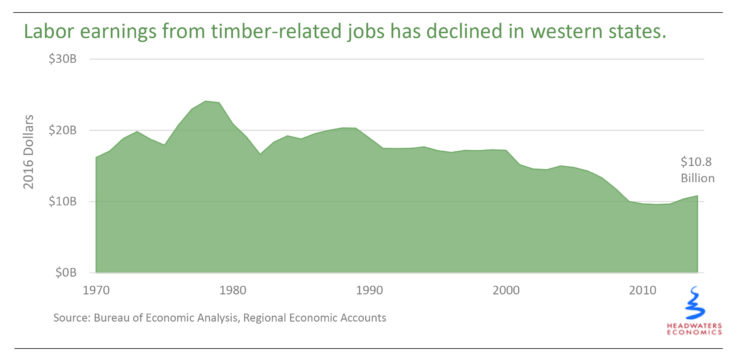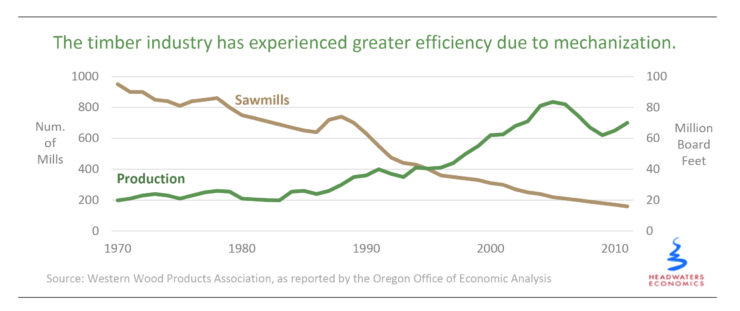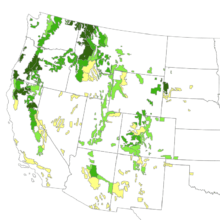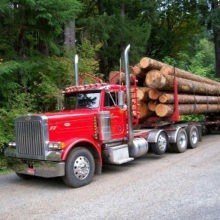Updated December 2021
- As a group, formerly timber-dependent counties are not doing better or worse than the rest of the West in key socioeconomic measures.
- Among the formerly timber-dependent counties there is wide variability in socioeconomic performance, with some counties outperforming their peers.
- Counties that weathered the timber transition provide economic development lessons. Counties doing better than average leveraged natural amenities; took an active, collaborative approach to planning; embraced adaptability; and took advantage of access to metropolitan markets.
For several decades, timber dominated a number of county economies in the West (defined as the 11 contiguous western states: Arizona, California, Colorado, Idaho, Montana, Nevada, New Mexico, Oregon, Utah, Washington, and Wyoming). In the 1970s, timber represented more than 20 percent of all earnings in 25 western counties; today, only a few counties earn more than ten percent from timber.
Like the rest of the West, formerly timber-dependent counties show diverse socioeconomic performance–some are holding steady, some are growing rapidly, and others are falling behind. This report draws lessons from formerly timber-dependent counties that fared better after timber harvests declined in the late 1980s and early 1990s.
These counties leveraged natural amenities; took an active, collaborative approach to planning; embraced adaptability; and took advantage of access to metropolitan markets.
Lessons from their transitions can inform current efforts to stabilize and diversify resource-dependent counties, including those currently experiencing the loss of major energy employers such as coal mines and coal-fired power plants.
Case studies in the report tell the stories of three counties—Bonner County, Idaho; Mason County, Washington; and Skamania County, Washington—each having better than average performance relative to other historically timber-dependent counties. We describe how they are adapting to major declines in timber jobs and income in different ways, and how their transitions can inform other communities.
Defining the Timber Transition
The report defines historically timber-dependent counties as those counties in which timber-related jobs contributed 20 percent or more of total workers’ earnings from 1970 to 1989, the period when labor earnings from timber-related jobs were highest.
This definition allows us to focus on the 25 most timber-dependent counties in the West, as shown in the dataviz map above. Throughout this study, historically timber-dependent counties are compared to other western counties with fewer than 200,000 people because historically timber-dependent counties tend to have small populations, ranging from approximately 7,000 to 119,000 people.
Why Timber Declined Across the West
The timber industry, which historically has been one of the most visible forms of manufacturing in the West and an important employer in some rural towns, has declined and changed in fundamental ways.
During the past several decades, the transition to fewer, larger, technologically sophisticated and automated mills has led to declines in timber jobs and income. Automation and increased efficiencies make the recovery of those jobs and income unlikely.
During the past 40 years, the number of lumber mills in the West declined steadily, from 950 in 1970 to 160 in 2011, even as average productivity of sawmills increased from less than 20 million board feet each year to more than 70 million board feet.
Automation is not the only factor affecting the timber industry in the West. During early 1990s, a national shift among federal land management agencies toward ecosystem management and a decreased emphasis on timber production resulted in lower commercial harvest levels across the West.
The 1994 Northwest Forest Plan, for example, resulted in sharp declines in timber harvested from federal lands in the Pacific Northwest, one of the most historically timber-dependent regions in the country. Between 1994 and 2000, timber employment in the Pacific Northwest is estimated to have decreased by roughly 10,000 jobs due to changed federal land management.
More recently, the Great Recession resulted in a massive decline in the U.S. housing market and decreased demand for wood products. This, in turn, resulted in the loss of 71,000 western timber jobs from 2005 to 2009 and the closure of 30 large western mills between 2009 and 2010.
Other factors that affect the western timber industry include the rapid rise of the Southeast as a major timber producer, international trade agreements, and increased imports from Canada.
Economic Performance in Historically Timber-Dependent Counties
All 25 historically timber-dependent counties defined in this study experienced declines in timber earnings since the 1970s and 1980s. The median decline in share of earnings from timber from 1970-1989 to 2001-2014 was 20 percentage points (ranging from -11 percentage points in Lewis County, Washington, to -37 percentage points in Skamania County, Washington).
The median change in average earnings from timber from 1970-1989 to 2001-2014 was -$64 million (in 2015 dollars), and ranges from a $30 million loss of average annual income in Grant County, Oregon, to a $304 million loss of average annual income in Douglas County, Oregon. [The methods for classifying workers changed between these time periods (1970-1989 versus 2001-2014). The earlier Standard Industrial Classification categorized workers according to what type of product they produced. The North American Industry Classification System groups workers based on the activities in which they are primarily engaged.]
Relative to other counties, historically timber-dependent counties also experienced a disproportionate decline in average wages across all sectors. On average, from 1970-1989 to 2001-2014, average annual wages per year dropped by $3,916 (in 2015 dollars) in former timber counties versus $1,558 in other non-timber-dependent counties with fewer than 200,000 people.
Current Performance Is Comparable in Counties With and Without Historic Timber Dependence
Despite the loss of a major employer and the associated declines in wages, current economic performance among historically timber-dependent counties, as a group, is comparable to other western counties with fewer than 200,000 residents.
We found no statistically significant differences between timber and non-timber counties according to three measures of socioeconomic performance:
1. Population change from 2000 to 2015 (in terms of annual change per 1,000 residents);
2.Wages across all sectors in 2015; and
3. Percent of families in poverty in 2015.
We found statistically significant differences between timber and non-timber counties according to two measures of socioeconomic performance:
- Median household income in 2015; and
- Percent of adults with a college degree in 2015.
We evaluated differences using simple paired t-tests (two-tailed, two-sample equal variance) for all indicators except median household income, for which we used a non-parametric test on the equality of medians. We found a wide spread in performance and extensive overlap with non-timber counties, which contributed to a lack of statistically significant differences for three of the five measures. (See figure below.)
The lack of statistically significant differences in population change, wages, and poverty rates suggests that timber dependence has limited long-term socioeconomic impacts. Although timber-related jobs often are relatively high-paying, this analysis demonstrates that in the long term, we do not see wages that are particularly higher or lower than in other comparable communities. Median household income and the share of adults with a college education are lower in timber-dependent communities. This finding suggests that timber-dependent communities lag behind comparable communities in human capital and wealth accumulation.
Economic Performance Varies Widely Among Historically Timber-Dependent Counties
Among historically timber-dependent counties, there is a wide range in current socioeconomic performance. Each of the 25 historically timber-dependent counties faces challenges, but several stand out as having above-average socioeconomic performance in recent years, and are profiled in case studies in the report: Bonner County, Idaho; Klickitat County, Washington; Mason County, Washington; and Skamania County, Washington.
Opportunities for Economic Transition
At the regional scale, job losses in timber have been more than offset by growth in other sectors. For example, the Pacific Northwest added 1.3 million jobs during the 1990s, a period marked by major losses in timber employment. (Roughly 30,000 timber jobs were lost during this time.) But job creation has not been evenly distributed across the West, and while some formerly timber-dependent communities have recovered, others have experienced persistent hardship.
The economic performance of historically timber-dependent counties in the West varies substantially. Some are growing, some are holding steady, and others continue to struggle after the loss of a major employer.
The economic performance of historically timber-dependent counties is similar to the performance of non-timber-dependent communities. Performance is shaped more by current challenges and opportunities in the regional economy affecting all types of communities than it is by changes in the timber industry alone.
Many western counties face difficult challenges including the loss of relatively higher-wage manufacturing jobs, including timber jobs, and the increased concentration of jobs in metropolitan areas. Strategies and opportunities exist, however, for economic transition and growth in these communities.
As the three case studies illustrate, a transition to a new, more diversified economy can be significantly aided through a variety of inherent characteristics (e.g., proximity to major metropolitan markets and natural amenities) and efforts of community leaders (e.g., an engaged and collaborative planning process, and strategies that embrace flexibility and adaptability to leverage unique advantages).
Western communities that more successfully navigated the loss of timber-related jobs and income employed one or more of the strategies outlined below to help improve local economic performance:
1. Leveraging natural amenities. Small towns with beautiful landscapes and access to outdoor recreation have a competitive advantage. Natural amenities may initially attract tourism and associated seasonal and low-wage jobs, but assets that attract tourists may also attract new residents, retirees, and entrepreneurs that can help diversify the economy. Tourism can jump-start the economy, leading to business expansion and retention in higher-wage sectors. Communities can pursue recreation and conservation as economic development strategies.
2. Demonstrating flexibility and embracing new economic opportunities. New opportunities in manufacturing, forest and watershed restoration, health care and retirement-related services, and tourism and recreation can diversify and grow rural economies. Identifying where these businesses and opportunities already exist and pursuing strategies to support local entrepreneurs is central to economic development and successful transitions. Adapting to new opportunities and technology in timber manufacturing and forest restoration can help communities continue the timber legacy.
3. Actively engaging in collaborative community planning and governance. Evidence from formerly timber-dependent communities shows that economic diversity results from deliberate efforts on the part of community leaders to build relationships and partnerships among government, businesses, and nonprofit organizations locally and with state and regional partners. Bonner County, Idaho is a good example of how these efforts allow communities to be strategic and effective in attracting funding and completing projects including upgrading infrastructure required by companies, offering workforce development and retention programs, helping remove barriers such as housing shortages, and creating or protecting amenities that result in a good quality of life for workers and their families.
4. Taking advantage of connections to metropolitan markets. Many historically timber-dependent counties are within commuting distance of major urban areas (for example, with residents of Mason County, Washington commuting to neighboring Olympia for work). Acceptable commute times are growing because people want to live in communities that have natural amenities. Counties that have the geographic advantage of natural beauty and access to recreation can leverage opportunities by expanding connections—via air travel, highways, public transit, and internet broadband—to major markets.
In some of the counties studied the timber industry continues to play a role in forest management and provides good-paying local jobs. The case studies provide insights into how specific strategies can help counties bring new economic opportunities to residents—especially in areas historically dependent on timber or other commodities. Today, a more diverse economy can provide economic opportunity and long-term stability to these counties.
This report was updated in December 2021 to reflect a change to a non-parametric statistical test and different conclusions for two of the five economic indicators.




